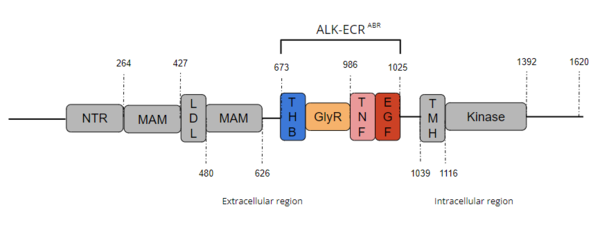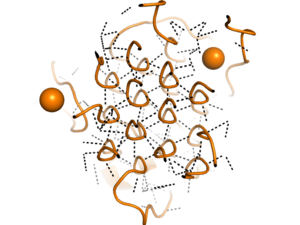Sandbox Reserved 1726
From Proteopedia
(Difference between revisions)
| Line 17: | Line 17: | ||
== Extracellular Domain Binding == | == Extracellular Domain Binding == | ||
=== Ligands === | === Ligands === | ||
| - | The extracellular ligands of ALK are Anaplastic Lymphoma Kinase Ligand 2 (ALKAL 2) and Anaplastic Lymphoma Kinase Ligand 1 (ALKAL 1). | + | The extracellular ligands of ALK are Anaplastic Lymphoma Kinase Ligand 2 (ALKAL 2) and Anaplastic Lymphoma Kinase Ligand 1 (ALKAL 1) which are polypeptides of 76 and 70 length respectively. |
==== ALKAL2 ==== | ==== ALKAL2 ==== | ||
| - | <scene name='90/904331/Alkal2/3'>ALKAL2</scene> is a shared ligand of ALK and LTK. | + | <scene name='90/904331/Alkal2/3'>ALKAL2</scene> is a shared ligand of ALK and LTK. Dimeric ALKAL2 and monomeric ALKAL2-AD both induce dimerization of ALK <ref name="Reshetnyak">PMID:34819673</ref>. Structurally, ALKAL2 has an N-terminal variable region, a conserved augmentor domain, and tends to aggregate in the cell <ref name="Reshetnyak" />. Overexpression of ALKAL2 is linked to high-risk [https://en.wikipedia.org/wiki/Neuroblastoma neuroblastoma] in absence of an ALK mutation <ref name="Borenas">PMID:33411331</ref>. |
==== ALKAL1 ==== | ==== ALKAL1 ==== | ||
<scene name='90/904331/Alkal1/5'>ALKAL1</scene> is a monomeric ligand of ALK. Structurally, ALKAL1 shares the same architecture as ALKAL2 with an N-terminal variable region and a conserved C-terminal augmentor domain <ref name="Reshetnyak" />. However, in ALKAL1, the N-terminal variable region is shorter, and has limited sequence similarity to ALKAL2. Overall, ALKAL1 still shares 91% sequence similarity with ALKAL2. Both ligands include a three helix bundle domain in their structures, with an extended positively charged surface for ligand binding <ref name="Reshetnyak" />. ALKAL1 as a monomer, however, binds to ALK with poor stability<ref name ="Chen">PMID:33391411</ref> and was only found to stimulate ALK dimerization at much higher concentrations than ALKAL2.<ref name="Reshetnyak2">PMID:26630010</ref> | <scene name='90/904331/Alkal1/5'>ALKAL1</scene> is a monomeric ligand of ALK. Structurally, ALKAL1 shares the same architecture as ALKAL2 with an N-terminal variable region and a conserved C-terminal augmentor domain <ref name="Reshetnyak" />. However, in ALKAL1, the N-terminal variable region is shorter, and has limited sequence similarity to ALKAL2. Overall, ALKAL1 still shares 91% sequence similarity with ALKAL2. Both ligands include a three helix bundle domain in their structures, with an extended positively charged surface for ligand binding <ref name="Reshetnyak" />. ALKAL1 as a monomer, however, binds to ALK with poor stability<ref name ="Chen">PMID:33391411</ref> and was only found to stimulate ALK dimerization at much higher concentrations than ALKAL2.<ref name="Reshetnyak2">PMID:26630010</ref> | ||
Revision as of 02:02, 21 April 2022
| This Sandbox is Reserved from February 28 through September 1, 2022 for use in the course CH462 Biochemistry II taught by R. Jeremy Johnson at the Butler University, Indianapolis, USA. This reservation includes Sandbox Reserved 1700 through Sandbox Reserved 1729. |
To get started:
More help: Help:Editing |
Anaplastic Lymphoma Kinase Extracellular Region
| |||||||||||
References
- ↑ 1.00 1.01 1.02 1.03 1.04 1.05 1.06 1.07 1.08 1.09 1.10 Huang H. Anaplastic Lymphoma Kinase (ALK) Receptor Tyrosine Kinase: A Catalytic Receptor with Many Faces. Int J Mol Sci. 2018 Nov 2;19(11). pii: ijms19113448. doi: 10.3390/ijms19113448. PMID:30400214 doi:http://dx.doi.org/10.3390/ijms19113448
- ↑ 2.00 2.01 2.02 2.03 2.04 2.05 2.06 2.07 2.08 2.09 2.10 2.11 2.12 2.13 2.14 2.15 2.16 2.17 2.18 2.19 Reshetnyak AV, Rossi P, Myasnikov AG, Sowaileh M, Mohanty J, Nourse A, Miller DJ, Lax I, Schlessinger J, Kalodimos CG. Mechanism for the activation of the anaplastic lymphoma kinase receptor. Nature. 2021 Dec;600(7887):153-157. doi: 10.1038/s41586-021-04140-8. Epub 2021, Nov 24. PMID:34819673 doi:http://dx.doi.org/10.1038/s41586-021-04140-8
- ↑ 3.0 3.1 3.2 3.3 Borenas M, Umapathy G, Lai WY, Lind DE, Witek B, Guan J, Mendoza-Garcia P, Masudi T, Claeys A, Chuang TP, El Wakil A, Arefin B, Fransson S, Koster J, Johansson M, Gaarder J, Van den Eynden J, Hallberg B, Palmer RH. ALK ligand ALKAL2 potentiates MYCN-driven neuroblastoma in the absence of ALK mutation. EMBO J. 2021 Feb 1;40(3):e105784. doi: 10.15252/embj.2020105784. Epub 2021 Jan 7. PMID:33411331 doi:http://dx.doi.org/10.15252/embj.2020105784
- ↑ 4.0 4.1 4.2 Chen S, Wang B, Fu X, Liang Y, Chai X, Ye Z, Li R, He Y, Kong G, Lian J, Li X, Chen T, Zhang X, Qiu X, Tang X, Zhou K, Lin B, Zeng J. ALKAL1 gene silencing prevents colorectal cancer progression via suppressing Sonic Hedgehog (SHH) signaling pathway. J Cancer. 2021 Jan 1;12(1):150-162. doi: 10.7150/jca.46447. eCollection 2021. PMID:33391411 doi:http://dx.doi.org/10.7150/jca.46447
- ↑ Reshetnyak AV, Murray PB, Shi X, Mo ES, Mohanty J, Tome F, Bai H, Gunel M, Lax I, Schlessinger J. Augmentor alpha and beta (FAM150) are ligands of the receptor tyrosine kinases ALK and LTK: Hierarchy and specificity of ligand-receptor interactions. Proc Natl Acad Sci U S A. 2015 Dec 29;112(52):15862-7. doi:, 10.1073/pnas.1520099112. Epub 2015 Nov 16. PMID:26630010 doi:http://dx.doi.org/10.1073/pnas.1520099112
- ↑ 6.0 6.1 6.2 6.3 Li T, Stayrook SE, Tsutsui Y, Zhang J, Wang Y, Li H, Proffitt A, Krimmer SG, Ahmed M, Belliveau O, Walker IX, Mudumbi KC, Suzuki Y, Lax I, Alvarado D, Lemmon MA, Schlessinger J, Klein DE. Structural basis for ligand reception by anaplastic lymphoma kinase. Nature. 2021 Dec;600(7887):148-152. doi: 10.1038/s41586-021-04141-7. Epub 2021, Nov 24. PMID:34819665 doi:http://dx.doi.org/10.1038/s41586-021-04141-7
- ↑ 7.0 7.1 Della Corte CM, Viscardi G, Di Liello R, Fasano M, Martinelli E, Troiani T, Ciardiello F, Morgillo F. Role and targeting of anaplastic lymphoma kinase in cancer. Mol Cancer. 2018 Feb 19;17(1):30. doi: 10.1186/s12943-018-0776-2. PMID:29455642 doi:http://dx.doi.org/10.1186/s12943-018-0776-2
- ↑ 8.0 8.1 Carpenter EL, Haglund EA, Mace EM, Deng D, Martinez D, Wood AC, Chow AK, Weiser DA, Belcastro LT, Winter C, Bresler SC, Vigny M, Mazot P, Asgharzadeh S, Seeger RC, Zhao H, Guo R, Christensen JG, Orange JS, Pawel BR, Lemmon MA, Mosse YP. Antibody targeting of anaplastic lymphoma kinase induces cytotoxicity of human neuroblastoma. Oncogene. 2012 Nov 15;31(46):4859-67. doi: 10.1038/onc.2011.647. Epub 2012 Jan, 23. PMID:22266870 doi:http://dx.doi.org/10.1038/onc.2011.647


